Proctitis Exercise Planner
Your Personalized Weekly Plan
Monday - Walking
Symptom Level:
Exercise Type: Low Impact
Duration: 30 minutes at moderate pace
Notes: Focus on steady breathing; pause if urgency occurs.
Tuesday - Gentle Yoga
Symptom Level:
Exercise Type: Low Impact
Duration: 15 minutes
Notes: Focus on pelvic floor strengthening with cat-cow and seated twists.
Wednesday - Rest Day
Symptom Level:
Exercise Type: Rest
Duration: Light stretching or meditation
Notes: Monitor symptom patterns and prepare for the week ahead.
Thursday - Swimming
Symptom Level:
Exercise Type: Low Impact
Duration: 20 minutes
Notes: Water supports the body and reduces pressure on the rectum.
Friday - Stationary Cycling
Symptom Level:
Exercise Type: Low Impact
Duration: 20 minutes at low resistance
Notes: Keep seat level to avoid excessive pressure.
Saturday - Light Hiking
Symptom Level:
Exercise Type: Low Impact
Duration: Varies
Notes: Stay hydrated and plan bathroom breaks.
Sunday - Full Rest
Symptom Level:
Exercise Type: Rest
Duration: Complete rest
Notes: Reflect on how the week’s activities affected your symptoms.
Living with Proctitis is a chronic inflammation of the rectal lining that can cause pain, urgency, and bleeding. It often makes the idea of moving around feel risky, but staying active is actually one of the best ways to keep symptoms in check and boost overall wellbeing. Below are realistic, doctor‑approved tips that let you stay fit without aggravating the condition.
Quick Takeaways
- Choose low‑impact activities like walking, swimming, or cycling.
- Listen to your body: stop if pain or urgency spikes.
- Stay hydrated and time bathroom breaks around workouts.
- Strengthen the pelvic floor with gentle core exercises.
- Combine movement with a soothing diet to reduce inflammation triggers.
Understanding Proctitis and How Activity Helps
When the rectal lining inflames, blood flow to the area can become erratic. Regular exercise promotes healthy circulation, which helps deliver oxygen and nutrients that aid tissue repair. Moreover, physical activity releases endorphins that naturally lower perceived pain and stress-both known to worsen symptoms like urgency.
Choosing the Right Types of Exercise
The goal is to move without putting excessive pressure on the rectum or pelvic floor. Below is a quick comparison of low‑impact versus high‑impact options.
| Aspect | Low‑Impact (Low‑impact exercise) | High‑Impact (High‑impact exercise) |
|---|---|---|
| Joint stress | Minimal | High |
| Rectal pressure | Low | Potentially high |
| Typical duration | 20‑45min | 15‑30min |
| Examples | Walking, swimming, stationary cycling, yoga | Running, jumping rope, HIIT |
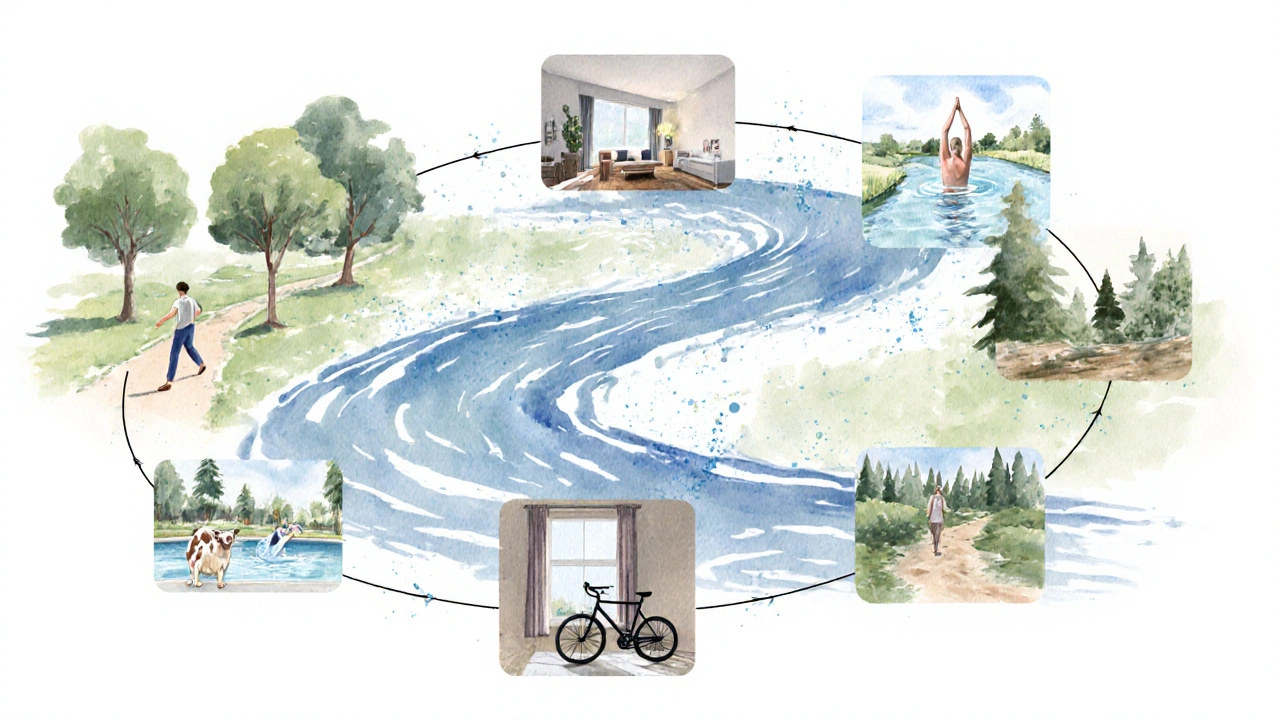
Getting Started: A Simple Weekly Plan
- Monday - 30‑minute brisk walk (moderate pace). Focus on steady breathing; pause if you feel urgency.
- Tuesday - 15‑minute gentle yoga session targeting the pelvic floor. Include cat‑cow stretches and seated twists.
- Wednesday - Rest or light stretching. Use this day to monitor symptom patterns.
- Thursday - 20‑minute swim or water aerobics. Water supports the body and reduces pressure on the rectum.
- Friday - 20‑minute stationary bike at low resistance. Keep the seat level to avoid excessive pressure.
- Saturday - Optional light hike or park walk. Stay hydrated and plan bathroom breaks.
- Sunday - Full rest. Reflect on how the week’s activities affected your symptoms. Adjust the next week’s plan accordingly.
Remember, consistency beats intensity. Even a short daily walk can improve blood flow to the colon and help keep the inflammation under control.
Pelvic Floor Strengthening - Why It Matters
A strong pelvic floor provides better support for the rectum and can reduce episodes of urgency. Simple exercises like Kegels, bridge lifts, and seated squeezing can be done while watching TV or during work breaks. Aim for three sets of 10 repetitions, holding each squeeze for 5 seconds.
Hydration, Nutrition, and Timing
Water is your best friend. Dehydration can harden stool, increasing strain during bowel movements, which aggravates proctitis. Aim for at least 2L of fluid daily, spread out to avoid sudden bladder pressure during workouts.
Eat a balanced diet rich in fiber (whole grains, fruits, vegetables) but watch for trigger foods that may inflame the colon-spicy dishes, caffeine, and alcohol are common culprits. Try a small, low‑fiber snack (like a banana) 30‑45minutes before exercising to avoid sudden bowel urgency.
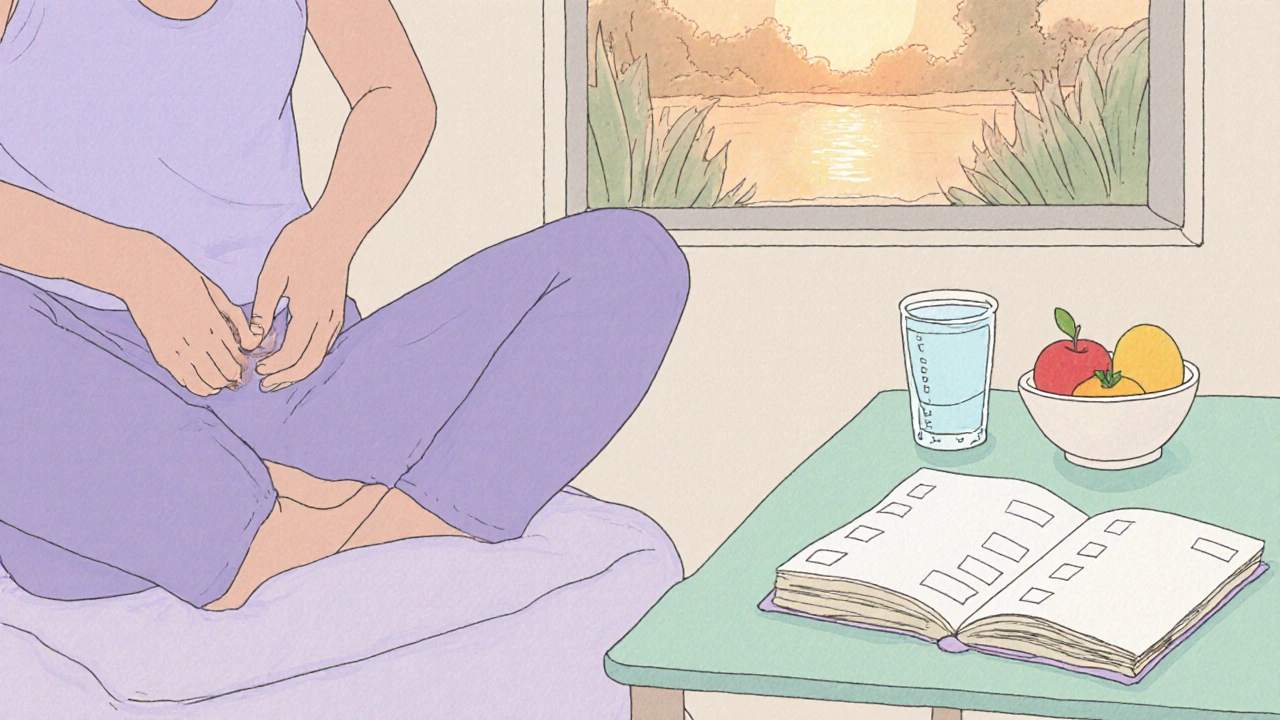
When to Pause or Seek Professional Help
If any of the following occur, stop the activity and contact your gastroenterologist:
- Sharp or worsening rectal pain during or after exercise.
- Sudden increase in bleeding or mucus discharge.
- Fever, chills, or unexplained weight loss.
These signs could indicate a flare‑up or an infection that needs medical attention.
Tools and Devices That Can Help
Consider using a supportive cushion or a ring-shaped seat pad when cycling. A gentle resistance band can add strength work without loading the pelvis. Wear breathable, moisture‑wicking clothing to keep the area dry and reduce irritation.
Staying Motivated: Tracking Progress
Use a simple journal or a phone app to record:
- Date and type of activity.
- Duration and intensity.
- Any symptom changes (pain level, urgency, bleeding).
Over time you’ll spot patterns-like which workouts keep you feeling best-making it easier to fine‑tune your routine.
Frequently Asked Questions
Can I run if I have proctitis?
Running creates repeated impact on the pelvis, which can increase pressure on the inflamed rectal lining. If you must run, keep the distance short, use a soft surface, and stop at the first sign of pain or urgency. Most patients find walking or cycling a safer alternative.
Is swimming safe during a flare‑up?
Yes. The buoyancy of water reduces pressure on the rectum, and the warm temperature can soothe muscle tension. Just make sure the pool is clean to avoid infections and shower promptly afterward.
How often should I do pelvic floor exercises?
Three times a day, with each session consisting of 10‑12 gentle squeezes held for 5‑10 seconds. Consistency is key; over‑exerting can cause soreness.
Should I avoid all caffeine?
Caffeine can irritate the bowel and increase urgency for some people. Try cutting back gradually; if symptoms improve, consider switching to decaf or herbal teas.
What’s the best time of day to work out?
Mid‑morning or early afternoon often works well because bowel movements tend to be more predictable. Avoid exercising right after large meals; give yourself 1‑2hours for digestion.

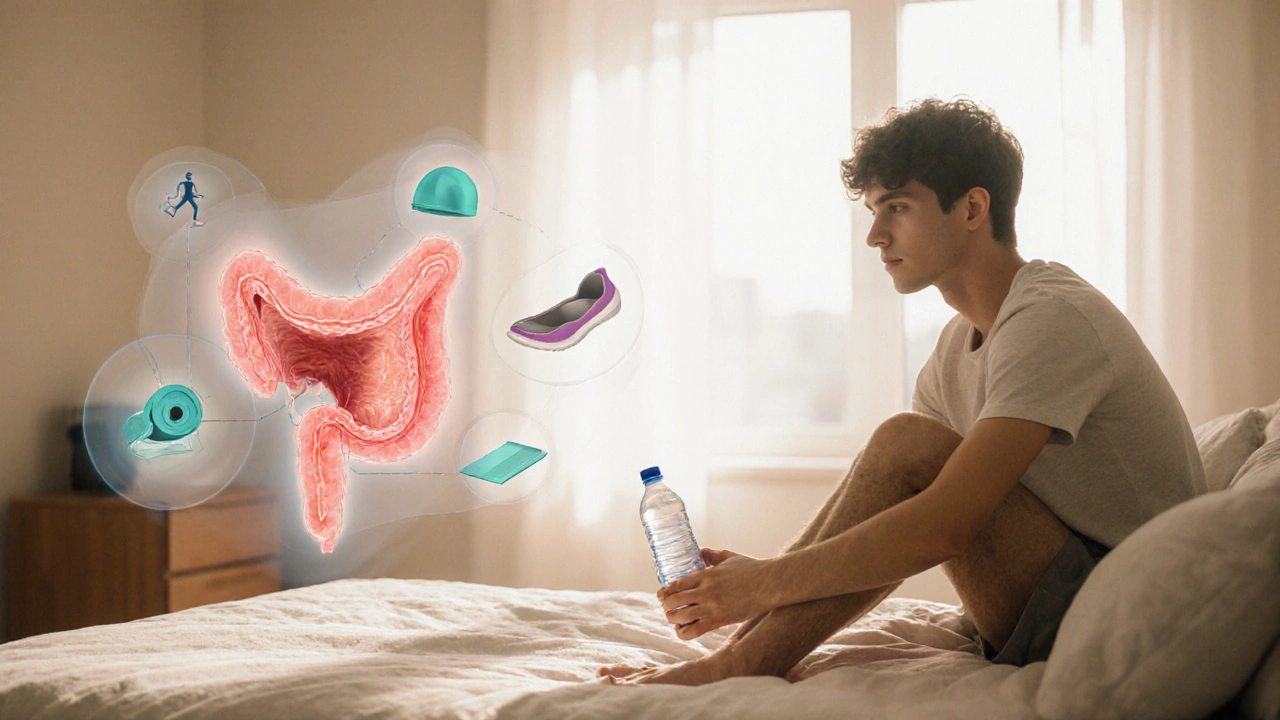


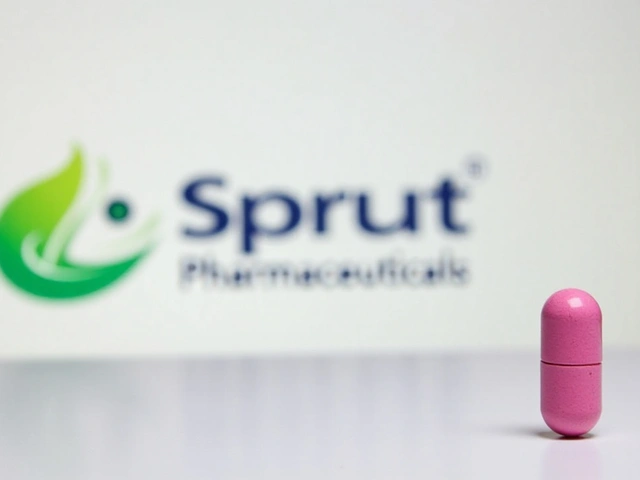


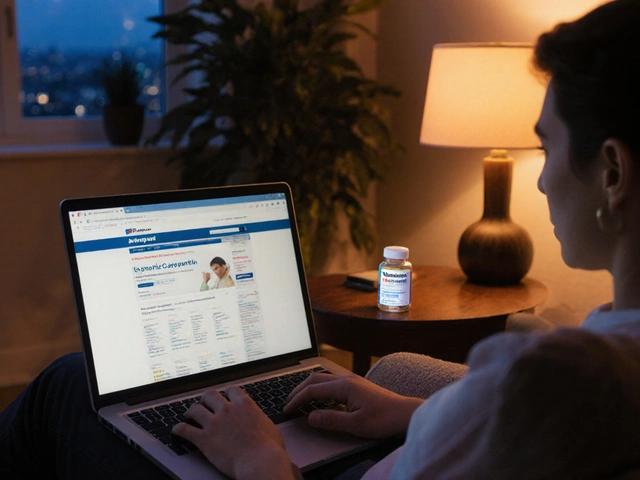
15 Comments
Joel Ouedraogo October 5, 2025
Life is a series of motions, and even a inflamed rectum cannot imprison the spirit of movement. When you honor the body with low‑impact exercise, you send a signal that pain does not dictate destiny. The circulation surge is a quiet rebellion against inflammation, a reminder that the gut is not a tyrant. Choose walking or swimming as a meditation in motion, not a punishment. Consistency, not intensity, is the true philosopher’s path to health.
Beth Lyon October 6, 2025
i love the idea of gentle yoga for proctitis.
Nondumiso Sotsaka October 6, 2025
Great rundown! 🙌 Remember to hydrate before each session and keep a small bathroom break plan handy. Pelvic floor squeezes in between sets can make a huge difference. If you ever feel a flare, swap a swim for a relaxed walk and listen to your body. Consistency will build strength and confidence, so keep at it! 😊
Ashley Allen October 7, 2025
Short walks are a solid start; they’re easy on the pelvis.
Brufsky Oxford October 7, 2025
Consider each stride as a thesis, each breath a proof. The low‑impact cadence reduces pressure, allowing the rectal lining to heal while the mind contemplates the rhythm of existence. In this way, exercise becomes a dialectic between body and ailment. Keep the resistance low and the intention pure :)
Lisa Friedman October 8, 2025
Actually, studies show that moderate aerobic activity can increase mucosal blood flow by up to 30%, which helps reduce inflammatory cytokines. Also, fiber intake should be balanced; too much can cause gas which might aggravate urgency. So pair your walks with a low‑FODMAP snack like a banana for optimal results.
cris wasala October 8, 2025
Hey everyone staying active is key you can do it keep the pace gentle and the breaks frequent it'll help your gut heal and your mood lift dont forget the supportive cushion on your bike for extra comfort
Tyler Johnson October 9, 2025
When you examine the physiological cascade triggered by low‑impact activity, the first observation is an enhancement of microcirculation that delivers oxygen and nutrients to compromised tissues. This gentle perfusion reduces hypoxic stress within the rectal mucosa, creating an environment less conducive to inflammatory mediator release. Moreover, the rhythmic nature of walking or swimming stimulates the autonomic nervous system, shifting the balance toward parasympathetic dominance. That shift not only calms the gut but also lowers systemic cortisol, a hormone known to exacerbate flare‑ups. The endorphin surge accompanying sustained movement acts as a natural analgesic, dulling the perception of discomfort without pharmacologic intervention. In parallel, consistent exercise promotes regular bowel motility, diminishing the likelihood of stool retention that can stretch the inflamed area. By avoiding sudden spikes in intra‑abdominal pressure, the pelvic floor maintains its supportive role, preventing unintended trauma to the rectal wall. Each low‑impact session also presents an opportunity to practice mindful breathing, which further relaxes the sphincteric muscles and reduces urgency. Hydration, often overlooked, synergizes with activity by softening stool consistency, thereby minimizing strain during defecation. Nutritional timing, such as a modest carbohydrate snack before a workout, can stabilize blood glucose and avert sudden energy dips that might trigger stress responses. The cumulative effect of these mechanisms is a more resilient gastrointestinal tract capable of withstanding routine irritants. From a psychological perspective, adhering to a structured exercise plan fosters a sense of agency, counteracting the helplessness that chronic illness can impose. This empowerment translates into better adherence to dietary recommendations and medication schedules. Additionally, the social component of group‑based low‑impact classes can provide emotional support, further buffering stress‑related flare triggers. Ultimately, the amalgamation of physiological, nutritional, and psychosocial benefits renders low‑impact exercise an indispensable component of comprehensive proctitis management.
Annie Thompson October 10, 2025
Wow Tyler you really went deep into the science, it's impressive how you linked microcirculation with mindfulness. Honestly, I sometimes feel overwhelmed reading such dense info, but I get it – the body is a complex machine. Still, I think the emotional aspect matters too; feeling isolated can make the pain feel worse. So while the data is solid, remember to check in with your mood and maybe share a laugh with a friend after a swim. That human connection can be just as therapeutic as the vascular benefits you described.
Parth Gohil October 10, 2025
Adding to Tyler's point, the concept of ‘shear stress modulation’ during aquatic exercise specifically reduces endothelial dysfunction in the rectal vasculature. In lay terms, this means water resistance gently massages the blood vessels, preventing the sticky clot formation that can exacerbate inflammation. So, a 20‑minute lap session not only burns calories but also normalizes nitric oxide production, which is key for vasodilation. Keep these mechanisms in mind when designing your weekly plan, and you’ll see both symptom relief and performance gains.
VAISHAKH Chandran October 11, 2025
One must recognise that the layman’s approach to low impact exercise is insufficient without an appreciation of the underlying biomechanical principles the elite few understand. The proprioceptive feedback loop during swimming, for instance, orchestrates a symphony of neuromuscular coordination that transcends mere calorie burning. Ignoring such nuances reduces the regimen to a crude regimen unfit for the discerning patient.
Pat Merrill October 11, 2025
Sure, because we all have a PhD in biomechanics before we even lace up our shoes, right? Maybe next you’ll tell us how to align our chakras before we sip water. 😂
Ian Parkin October 12, 2025
While the enthusiasm for advanced theory is commendable, the practical recommendations remain paramount; simple guidance on walking pace and hydration often delivers the most immediate benefit to patients.
Howard Mcintosh October 12, 2025
Love the positive vibe, cris! Just a tip: try setting a reminder on your phone for bathroom breaks during longer sessions – it keeps the flow smooth and avoids any surprise urgency.
Jeremy Laporte October 13, 2025
Great point, cris. Also, consider using a gel seat cushion on the bike; it distributes pressure evenly and can make those stationary cycling days way more comfortable.